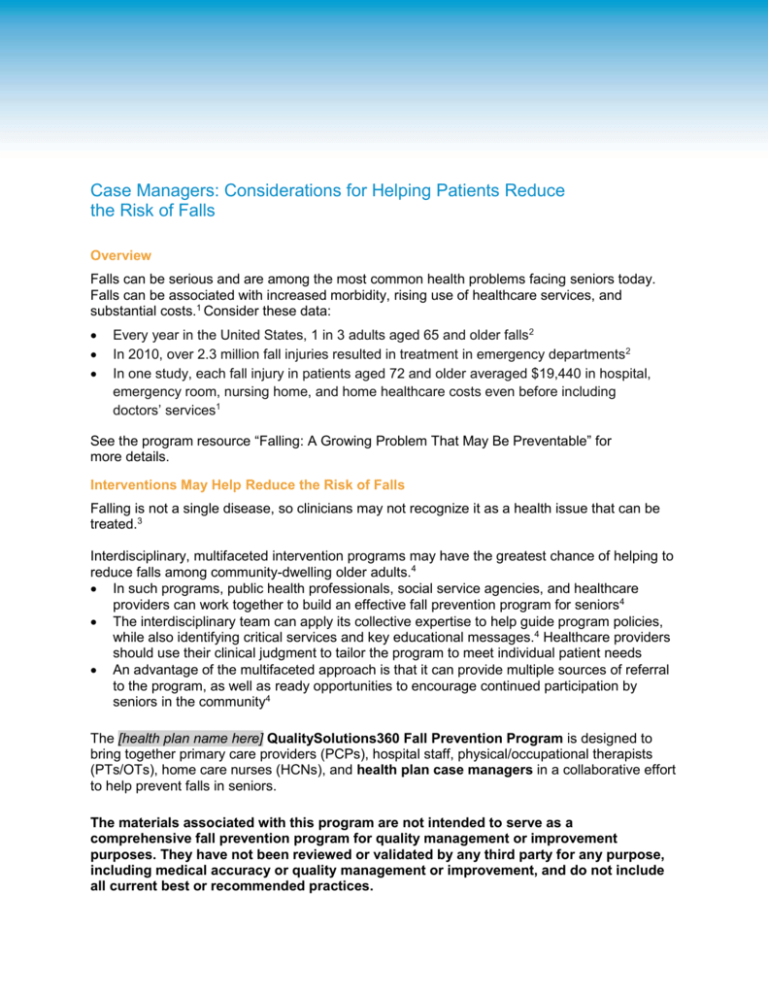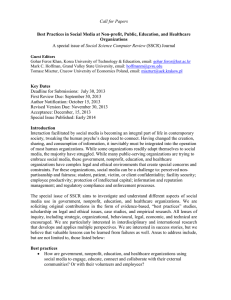Case Manager Considerations to Reduce the Risk for Fall
advertisement

Case Managers: Considerations for Helping Patients Reduce the Risk of Falls Overview Falls can be serious and are among the most common health problems facing seniors today. Falls can be associated with increased morbidity, rising use of healthcare services, and substantial costs.1 Consider these data: Every year in the United States, 1 in 3 adults aged 65 and older falls2 In 2010, over 2.3 million fall injuries resulted in treatment in emergency departments2 In one study, each fall injury in patients aged 72 and older averaged $19,440 in hospital, emergency room, nursing home, and home healthcare costs even before including doctors’ services1 See the program resource “Falling: A Growing Problem That May Be Preventable” for more details. Interventions May Help Reduce the Risk of Falls Falling is not a single disease, so clinicians may not recognize it as a health issue that can be treated.3 Interdisciplinary, multifaceted intervention programs may have the greatest chance of helping to reduce falls among community-dwelling older adults.4 In such programs, public health professionals, social service agencies, and healthcare providers can work together to build an effective fall prevention program for seniors4 The interdisciplinary team can apply its collective expertise to help guide program policies, while also identifying critical services and key educational messages.4 Healthcare providers should use their clinical judgment to tailor the program to meet individual patient needs An advantage of the multifaceted approach is that it can provide multiple sources of referral to the program, as well as ready opportunities to encourage continued participation by seniors in the community4 The [health plan name here] QualitySolutions360 Fall Prevention Program is designed to bring together primary care providers (PCPs), hospital staff, physical/occupational therapists (PTs/OTs), home care nurses (HCNs), and health plan case managers in a collaborative effort to help prevent falls in seniors. The materials associated with this program are not intended to serve as a comprehensive fall prevention program for quality management or improvement purposes. They have not been reviewed or validated by any third party for any purpose, including medical accuracy or quality management or improvement, and do not include all current best or recommended practices. Considerations for the Case Manager* The case manager can play an important role in a treatment plan by contacting patients and coordinating their care among selected members of the interdisciplinary team. 5 In collaboration with hospital discharge planners and hospital case managers, the case manager can identify hospitalized patients who would be candidates for case management services The case manager may coordinate with the interdisciplinary team members to collaboratively assess, plan, and intervene to meet the individual’s health needs. By using available case-management resources and communications with the interdisciplinary team and patients and their families, the case manager can promote quality, cost-effective outcomes5,6 The case manager may contact the interdisciplinary team for follow-up activities such as assessment, rehabilitation, and environmental inspection5 Based on the findings and recommendations of the interdisciplinary team, the case manager, in cooperation with the PCP and other healthcare providers, can arrange for patient-specific services5,6 For patients identified as candidates for assessment and interventions to reduce the risk of falls, some of the interdisciplinary team members may include: – PTs, who can play a role in assessments and interventions intended to improve gait, balance, and muscle strength.7,8 If the patient is found to be at risk, PTs may make recommendations to the PCP and case manager for rehabilitative interventions designed to address these deficiencies – OTs, who may conduct environmental evaluations of patients’ homes for potential fall risks.8,9 They can also assist patients and families to ensure that fall prevention activities recommended by the PCP and case manager are understood and followed7 The case manager may follow the progress of patients during rehabilitation or hospitalization until discharged home and under the care of their PCP Some fall prevention activities can be initiated by the PCP through a routine patient examination and may not need to involve the case manager The risk of falling among our senior population continues to create challenges for patients, families, caregivers, and the healthcare professional. Interdisciplinary, multifaceted intervention programs aimed directly at community-dwelling seniors may help in reducing falls among older adults.4 *Not an all-inclusive list. Healthcare professionals should use their clinical judgment in determining the best approach for managing patients. References 1. Costs of falls among older adults. Centers for Disease Control and Prevention Web site. http://www.cdc.gov/HomeandRecreationalSafety/Falls/fallcost.html. Updated December 8, 2010. Accessed June 1, 2011. 2. Falls among older adults: an overview. Centers for Disease Control and Prevention Web site. http://www.cdc.gov/HomeandRecreationalSafety/Falls/adultfalls.html. Updated December 8, 2010. Accessed June 1, 2011. 3. The Connecticut Collaboration for Fall Prevention. Fall Prevention Web site. Clinical approach. http://www.fallprevention.org/pages/clinicians.htm. Last modified June 24, 2010. Accessed June 1, 2011. 4. Washington State Department of Health. Falls among older adults: strategies for prevention. http://www.doh.wa.gov/hsqa/emstrauma/injury/pubs/FallsAmongOlderAdults.pdf. Posted September 2002. Accessed June 1, 2011. 5. Mullahy CM. Case management and managed care. In: Kongstvedt PR, ed. The Managed Health Care Handbook. 4th ed. Gaithersburg, MD: Aspen Publishers, Inc; 2001:371-401. 6. Standards of Practice for Case Management, Revised 2010. Case Management Society of America Web site. http://www.cmsa.org/portals/0/pdf/memberonly/StandardsOfPractice.pdf. Accessed August 14, 2014. 7. American Geriatrics Society and British Geriatrics Society Panel on Prevention of Falls in Older Persons. Summary of the updated American Geriatrics Society/British Geriatrics Society clinical practice guideline for prevention of falls in older persons. J Am Geriatr Soc. 2011;59(1):148-157. 8. Tinetti ME. Preventing falls in elderly persons. N Engl J Med. 2003;348(1):42-49. 9. Cumming RG, Thomas M, Szonyi G, et al. Home visits by an occupational therapist for assessment and modification of environmental hazards: a randomized trial of falls prevention. J Am Geriatr Soc. 1999;47(12):1397-1402. This information has been developed by Johnson & Johnson Health Care Systems Inc. as part of the QualitySolutions360 platform supporting healthcare management programs. © Johnson & Johnson Health Care Systems Inc. 2014 September 2014 017966-140707 Approved 10/10/2014







